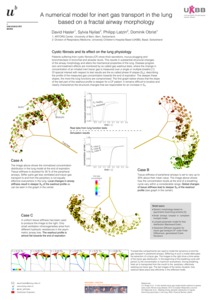Hasler, David; Nyilas, Sylvia; Latzin, Philipp; Obrist, Dominik (30 August 2015). A numerical model for inert gas transport in the lung based on fractal airway morphology (Unpublished). In: Computational Fluid Dynamics in Medicine and Biology II. Albufeira, Portugal. 30.08.-04.09.2015.
|
Text
Abstract_CFDII_Hasler_final.pdf - Accepted Version Available under License BORIS Standard License. Download (165kB) | Preview |
|
![[img]](https://boris.unibe.ch/68445/8.hassmallThumbnailVersion/CFDII_Albufeira_f.png)
|
Slideshow
CFDII_Albufeira_f.png - Presentation Available under License BORIS Standard License. Download (1MB) | Preview |
Patients suffering from cystic fibrosis (CF) show thick secretions, mucus plugging and bronchiectasis in bronchial and alveolar ducts. This results in substantial structural changes of the airway morphology and heterogeneous ventilation. Disease progression and treatment effects are monitored by so-called gas washout tests, where the change in concentration of an inert gas is measured over a single or multiple breaths. The result of the tests based on the profile of the measured concentration is a marker for the severity of the ventilation inhomogeneity strongly affected by the airway morphology. However, it is hard to localize underlying obstructions to specific parts of the airways, especially if occurring in the lung periphery.
In order to support the analysis of lung function tests (e.g. multi-breath washout), we developed a numerical model of the entire airway tree, coupling a lumped parameter model for the lung ventilation with a 4th-order accurate finite difference model of a 1D advection-diffusion equation for the transport of an inert gas. The boundary conditions for the flow problem comprise the pressure and flow profile at the mouth, which is typically known from clinical washout tests. The natural asymmetry of the lung morphology is approximated by a generic, fractal, asymmetric branching scheme which we applied for the conducting airways. A conducting airway ends when its dimension falls below a predefined limit. A model acinus is then connected to each terminal airway. The morphology of an acinus unit comprises a network of expandable cells. A regional, linear constitutive law describes the pressure-volume relation between the pleural gap and the acinus. The cyclic expansion (breathing) of each acinus unit depends on the resistance of the feeding airway and on the flow resistance and stiffness of the cells themselves. Special care was taken in the development of a conservative numerical scheme for the gas transport across bifurcations, handling spatially and temporally varying advective and diffusive fluxes over a wide range of scales. Implicit time integration was applied to account for the numerical stiffness resulting from the discretized transport equation.
Local or regional modification of the airway dimension, resistance or tissue stiffness are introduced to mimic pathological airway restrictions typical for CF. This leads to a more heterogeneous ventilation of the model lung. As a result the concentration in some distal parts of the lung model remains increased for a longer duration. The inert gas concentration at the mouth towards the end of the expirations is composed of gas from regions with very different washout efficiency. This results in a steeper slope of the corresponding part of the washout profile.


